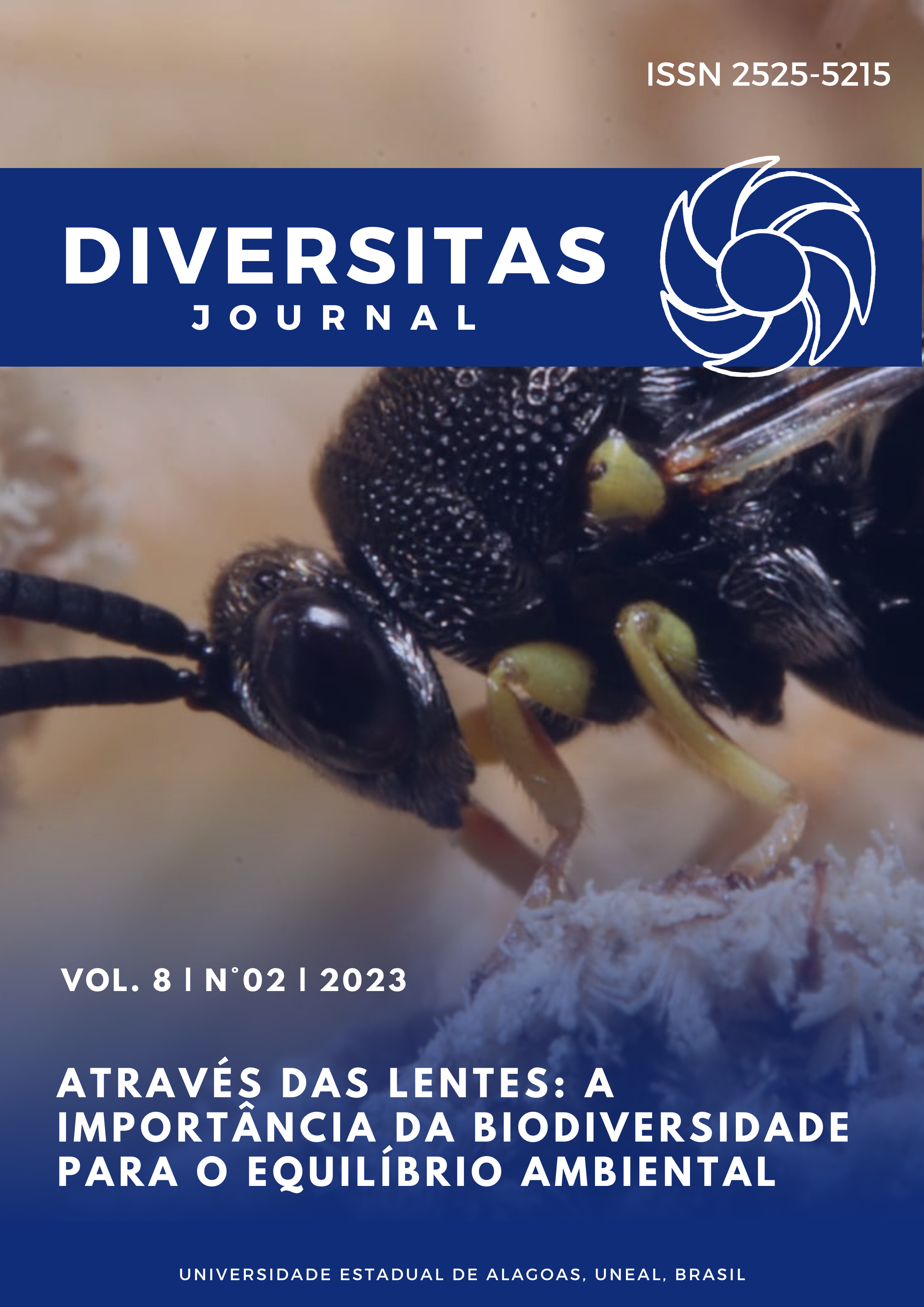Ethnobotanical knowledge in the Quilombo of Castainho, Garanhuns - Pernambuco
DOI:
https://doi.org/10.48017/dj.v8i2.2556Keywords:
Ethnobotany, Traditional communities, Afro-descendant, Popular knowledge, Northeast of BrazilAbstract
The quilombola communities are distributed throughout the Brazilian territory, living on subsistence activities such as agriculture and livestock. The study of these populations contributes to the recording of knowledge, culture and associated biodiversity. The present work aimed to analyze the knowledge about the diversity of useful plants of Castainho, Garanhuns - Pernambuco. The research was conducted through semi-structured interviews, associated with the guided tour technique that consists of collecting the species mentioned with the help of a local specialist. After collecting the plants, they were dried in an oven at 40ºC, prepared in exsiccates and taken for identification. Data from the interviews were categorized in Excel. Statistical analyses were performed using the Bioestat 5.3 software. As a result, 64 people participated between men (25%) and women (75%). The age range of the informants ranged from 18 to 91 years, with a higher frequency in the range of 47 to 57, the age at which there was a greater number of citations. We recorded 158 ethnospecies arranged in 68 botanical families composed of native (40%) and exotic (60%) species indicated mainly as food and medicinal. The territorial fragmentation of the community and the real estate expansion in its surroundings are factors locally associated with the reduction of diversity, which may justify the lower rate of native plants. The lack of interest among the younger ones and the forgetfulness reported by the elderly can compromise the transmission of knowledge. Women have a strong participation in the maintenance of traditional practices. They constitute a way to strengthen biocultural relations in Castainho.
Metrics
References
Albuquerque, U. P., Lucena R. F. P. D., Freitas Lins Neto E. M. D. (2014). Selection of research participants. In Methods and techniques in ethnobiology and ethnoecology (pp. 1-13). Humana Press, New York, NY.
Ayres, M. e Ayres, D. L. (2007). Aplicações estatísticas nas áreas das ciências biológicas e médicas. BioEstat (5.0), Belém, Pará, Brasil.
Ávila, J. V. C., Mello, A. S. D., Beretta, M. E., Trevisan, R., Fiaschi, P., Hanazaki, N. (2017). Agrobiodiversity and in situ conservation in quilombola home gardens with different intensities of urbanization. Acta Botânica Brasílica, 31, pp. 1–10. https://www.scielo.br/j/abb/a/MkMHjQLBmwK7szyZRT7ZgCf/?lang=en
Ávila, J. V. C.; Zank, S.; Valadares, K. M. de O.; Maragno, J. M.; Hanazaki, N. (2015). The traditional knowledge of Quilombola about plants: does urbanization matter? Ethnobotany Research and Applications, 14, pp.453- 462. https://ethnobotanyjournal.org/index.php/era/article/view/1103
Beltreschi, L., Lima, R. B., Cruz, D. D. (2019). Traditional botanical knowledge of medicinal plants in a “quilombola” community in the Atlantic Forest of northeastern Brazil. Environment, Development and Sustainability, 21 (3), pp. 1185–1203.https://www.researchgate.net/publication/322403915_Traditional_botanical_knowledge_of_medicinal_plants_in_a_quilombola_community_in_the_Atlantic_Forest_of_northeastern_Brazil
Cardoso, C. S., Melo, L. O. de, Freitas, D. A. (2018). Health conditions in quilombola communities las condiciones de salud en las comunidades quilombola. Revista de enfermagem, 12 (4), pp. 1037-1045.
Carneiro, A. F. T., Nichols, S. E. (2007). Impactos sociais da mudança do referencial geodésico: o caso da demarcação do território quilombola Castainho. II simpósio brasileiro de geomática, Presidente Prudente.
Ceolin, T., Heck, R. M., Barbieri, R. L., Schwartz, E., Muniz, R. M., Pillon, C. N. (2011). Plantas medicinais: transmissão do conhecimento nas famílias de agricultores de base ecológica no Sul do RS. Revista da Escola de Enfermagem da USP, 45 (1), pp. 47-54.https://www.scielo.br/j/reeusp/a/RhYtqkRwFSRDYBR6gGqZhxM/abstract/?lang=pt
CPISP - COMISSÃO PRÓ-ÍNDIO DE SÃO PAULO. (s.d.). Quilombolas no Brasil. Disponível em: http://cpisp.org.br/direitosquilombolas/observatorio-terras-quilombolas/quilombolas-brasil/. Acesso em: 01 out. 2019.
CONAQ – Coordenação Nacional de Articulações das Comunidades Negras Rurais Quilombolas. (s.d.) Disponível em: http://conaq.org.br/quem-somos/Acesso em 15 de dezembro de 2022.
Costa, J. C., Marinho, M. G. V. (2016). Etnobotânica de plantas medicinais em duas comunidades do município de Picuí, Paraíba, Brasil. Revista Brasileira de Plantas Medicinais, 18 (1), pp. 125-134. https://www.scielo.br/j/rbpm/a/JJSBqTZt7fxpQFMzCzkdXBP/abstract/?lang=pt
Diniz, R. F. (2019). Etnosaberes e culturas tradicionais afrobrasileiras: farmacopeia, magia e reprodução material e simbólica de comunidades quilombolas do vale do jequitinhonha-MG. GEOgraphia, 21 (47), pp. 14-28.https://periodicos.uff.br/geographia/article/view/28178/23458
Durand, M. K., Heidemann, I. T. S. B. (2020). Saúde das mulheres quilombolas: diálogo com a literatura. Revista Integrativa de Literatura, 12, pp. 203-210.https://pesquisa.bvsalud.org/portal/resource/pt/biblio-1047752
Faria, J. L. M., Albuquerque, U. P. (2018) Como fatores socioeconômicos podem afetar o conhecimento de plantas medicinais? Revista Brasileira de Meio Ambiente, 3(1), pp. 33-36.
https://www.revistabrasileirademeioambiente.com/index.php/RVBMA/article/view/35/84
Farias, P. S. et al. (2021). Plantas medicinais utilizadas por mulheres em comunidades quilombolas do Recôncavo Baiano. Research, Society and Development, 10 (12), pp. 1-13. https://rsdjournal.org/index.php/rsd/article/download/19916/18287/249340
Ferreira, A. L. S., Batista, C. A. S., Pasa, M. C. (2015). Uso de plantas medicinais na comunidade quilombola mata cavalo em nossa senhora do livramento – MT, Brasil. Biodiversidade, 14 (1).pp. 151-160.
https://periodicoscientificos.ufmt.br/ojs/index.php/biodiversidade/article/view/2258
Forzza, R. C. Leitman, P. M., Costa, A., Carvalho Jr., A. A., Peixoto, A.L., Walter, B. M. T., Bicudo, C., Zappi, D., Costa, D. P., Lleras, E., Martinelli, G., Lima, H. C., Prado, J., Stehmann, J. R., Baumgratz, J. F. A., Pirani, J. R., Sylvestre, L. da S., Maia, L. C., Lohmann, L.G., Paganucci, L., Silveira, M., Nadruz, M., Mamede, M. C. H., Bastos, M. N. C., Morim, M. P., Barbosa, M. R., Menezes, M., Hopkins, M., Secco, R., Cavalcanti, T., Souza, V.C. (2010). Catálogo de plantas e fungos do Brasil. Rio de Janeiro: Instituto de Pesquisas Jardim Botânico do Rio de Janeiro, 2010. 828p. Disponível em: https://reflora.jbrj.gov.br/reflora.
Florentino, A. T. N., Araújo, E. L., Albuquerque, U. P. (2007). Contribuição de quintais agroflorestais na conservação de plantas da Caatinga, Município de Caruaru, PE, Brasil. Acta Botanica Brasilica, 21 (1): 37-47.https://www.scielo.br/j/abb/a/vGhvWYtMPXwJptqZYwMJsdP/?lang=pt
Fundação Palmares, 2016. Disponível em: http://www.palmares.gov.br/. Acesso em 25 de março de 2022.
Gomes, T. B., Bandeira, F. P. S. F. (2012). Uso e diversidade de plantas medicinais em uma comunidade quilombola no Raso da Catarina, Bahia. Acta Botanica Brasilica, 26 (4), pp. 796-809. https://periodicos.unifap.br/index.php/biota/article/viewFile/2902/v7n3p57-68.pdf
Guedes, A. C. B. (2018). Mulheres quilombolas e uso de plantas medicinais: práticas de cura em Santa Rita de Barreira/PA. 203 f. Dissertação (Mestrado) – Programa de Pós-Graduação em Desenvolvimento Sustentável do Trópico Úmido, Universidade Federal do Pará, Belém. http://repositorio.ufpa.br/jspui/bitstream/2011/10283/1/Dissertacao_MulheresQuilombolaUso.pdf
Guimarães, B. O., Oliveira, A. P., Morais, I. L. (2019). Plantas medicinais de uso popular na comunidade quilombola de Piracanjuba - Ana Laura, Piracanjuba, GO. Journal of Social, Technological and Environmental Science, 8 (3), pp. 196-220.http://periodicos.unievangelica.edu.br/index.php/fronteiras/article/view/3208
INCRA. (2012) Relatório Territórios Quilombolas. Disponível em: http://www.incra.gov.br/index.php/servicos/publicacoes/livros-revistas-ecartilhas/file/1195-relatorio-regularizacao-quilombolas-2012-incra. Acesso em: 20 de abril de 2021.
Lima, M., Cavalcanti, L. H. C., Bergamasco, S. M. P. P. (2015). Potencial de uso de cercas vivas em assentamento rural: estudo de caso no assentamento Pitanga, Pernambuco, nordeste Brasileiro. Retratos de Assentamentos, 18 (1), pp. 291-318.https://retratosdeassentamentos.com/index.php/retratos/article/view/191
Lisboa, M. S., Pinto, A. S., Barreto, P. A., Ramos, Y. J., Silva, M., Capputo, M., Almeida, M. Z. (2017). Estudo etnobotânico em comunidade quilombola Salamina/Putumujú em Maragogipe, Bahia. Revista Fitos, Rio de Janeiro, 11 (1), p.1-118.
Löbler, L., Santos, D, Rodrigues, E. dos S., Zamberlan, N. R. dos S. (2014.) Levantamento etnobotânico de plantas medicinais no bairro Três de Outubro da cidade de São Gabriel, RS, Brasil. Revista Brasileira de Biociências, Porto Alegre 12 (2), pp. 81-89. http://www.ufrgs.br/seerbio/ojs/index.php/rbb/article/view/2756
Mélo, C. F. T. (2018). Memórias e sentidos de natureza nas práticas educativas da comunidade quilombola Castainho/PE. Pp. 154 f. Tese (Doutorado em Desenvolvimento e Meio Ambiente) – Universidade Federal de Sergipe, São Cristóvão, SE. http://bdtd.ibict.br/vufind/Record/UFS-2_57b7e4e030a9ad6108b0666c98ca6484
Mota, R. S., Dias, H. M. (2012). Quilombolas e recursos florestais medicinais no sul da Bahia, Brasil. Interações, Campo Grande 13 (2).https://www.interacoes.ucdb.br/interacoes/article/view/310
Nunes, A. T. e Duarte, C. H. C. (2021). Plantas úteis nos quintais da comunidade quilombola do Castainho, Garanhuns – Pernambuco. In: Perspectivas teóricas e práticas das relações humanas com a natureza. Orgs: Marcelo Alves Ramos, Washington Ferreira Júnio - Recife, PE: Edupe: pp. 154.
Oliveira, L. R. (2015). Uso popular de plantas medicinais por mulheres da comunidade quilombola de Furadinho em Vitória da Conquista, Bahia, Brasil. Revista Verde de Agroecologia e Desenvolvimento Sustentável, Pombal 10 (3), pp. 25-31. https://www.gvaa.com.br/revista/index.php/RVADS/article/view/3408
Pereira, A. S., Magalhães, L. (2023) A vida no quilombo: trabalho, afeto e cuidado nas palavras e imagens de mulheres quilombolas. Interface (Botucatu). pp. 27 e210788 https://doi.org/10.1590/interface.210788
Phillips, O., Gentry, A. H. (1993a.) The Useful Plants of Tambopata, Peru: I. Statistical Hypotheses Tests with a New. Quantitative Technique, 47 (1): 15-32. https://rainfor.org/upload/publication-store/1993/Phillips/Phillips_Gentry1993EconBot_quantitative1.pdf
Phillips, O., Gentry, A. H. (1993b). The Useful Plants of Tambopata, Peru: II. Additional Hypothesis Testing in Quantitative Ethnobotany. Quantitative Technique 47 (1): 33-43. https://www.researchgate.net/publication/260048281_Phillips_OL_Gentry_AH_1993_The_useful_plants_of_Tambopata_Peru_II_Additional_hypothesis_testing_in_quantitative_ethnobotany_Economic_Botany_47_33-43
Prada, M. de la C., Nunes, A. T., Oliveira, A. F. M. & Cavalcanti , L. H. (2022). Multifunctional plants used in the diet of Quilombolas in the Castainho Community (Garanhuns, Pernambuco). Ethnobotany Research and Applications, 24, 1–12. Retrieved from https://ethnobotanyjournal.org/era/index.php/era/article/view/3879
Santos, J., Silveira, A., Gomes, V. (2019). Knowledge and use of the flora in a quilombola community of Northeastern Brazil. Floresta e Ambiente, 23 maio. 26 (3). https://www.scielo.br/scielo.php?script=sci_arttext&pid=S2179-80872019000300108&tlng=en
Santos, M. P. M. (2010). A comunidade de Castainho: uma contribuição aos estudos geográficos de remanescentes de quilombos em Garanhuns, Pernambuco. 2010. 135 f. Dissertação (Mestrado) - Programa de Pós- Graduação em Geografia, Universidade Federal de Pernambuco, Recife. https://repositorio.ufpe.br/handle/123456789/6617
SBPC – Sociedade Brasileira para o Progresso da Ciência. (2022). Povos tradicionais e biodiversidade no Brasil [recurso eletrônico]: Contribuições dos povos indígenas, quilombolas e comunidades tradicionais para a biodiversidade, políticas e ameaças / Manuela Carneiro da Cunha, Sônia Barbosa Magalhães e Cristina Adams, organizadoras. – São Paulo. Disponível em: http://portal.sbpcnet.org.br/livro/povostradicionais16.pdf
Silva, A. J. R., Andrade, L.H.C. (2005). Etnobotânica nordestina: estudo comparativo da relação entre comunidades e vegetação na Zona do Litoral - Mata do Estado de Pernambuco, Brasil. Acta Botânica Brasílica, 19 (1): 45-60.
Silva, F. S., Ramos, M.A., Hanazaki, N., Albuquerque, U.P. 2011. Dynamics of traditional knowledge of medicinal plants in a rural community in the Brazilian semiarid region. Revista Brasileira de Farmacognosia 21, pp. 382-391.
Silva, P. H., Oliveira, Y. R, Abreu, M. C. (2017). Uma abordagem etnobotânica acerca das plantas úteis cultivadas em quintais em uma comunidade rural do semiárido piauiense, Nordeste do Brasil. Journal of Environmental Analysis and Progress, 2 (2), pp. 144–159.
Silvestre, G. Z.; Nunes, A. T. (2022). Percepção de mulheres quilombolas sobre as doenças locais e formas de tratamentos. Gaia Scientia, 16 (2), pp. 58-71. DOI: 10.22478/ufpb.1981-1268.2022v16n2.62383. Disponível em: https://periodicos.ufpb.br/index.php/gaia/article/view/62383. Acesso em: 20 dez. 2022.
Vandebroek, I., Balick, M. J. (2012). Globalization and Loss of Plant Knowledge: Challenging the Paradigm. Plos one, 7 (5).
https://journals.plos.org/plosone/article?id=10.1371/journal.pone.0037643
Willis, K. J. (2017). Estado das Plantas do Mundo. Londres (Reino Unido): Royal Botanic Gardens, Kew; Disponível em: https://www.ncbi.nlm.nih.gov/books/NBK464489/
ZANK, S.; ÁVILA, J. V. C1; HANAZAKI, N. (2016). Compreendendo a relação entre saúde do ambiente e saúde humana em comunidades Quilombolas de Santa Catarina. Revista Brasileira de Plantas Medicinais, Campinas, 18 (1), pp.157-167. https://www.scielo.br/j/rbpm/a/9KJfhszR36jKDzHrNkBdLQB/?lang=pt&format=pdf
Downloads
Published
How to Cite
Issue
Section
License
Copyright (c) 2023 Alissandra Trajano Nunes, Roberta Santos de Lima

This work is licensed under a Creative Commons Attribution 4.0 International License.
The Diversitas Journal expresses that the articles are the sole responsibility of the Authors, who are familiar with Brazilian and international legislation.
Articles are peer-reviewed and care should be taken to warn of the possible incidence of plagiarism. However, plagiarism is an indisputable action by the authors.
The violation of copyright is a crime, provided for in article 184 of the Brazilian Penal Code: “Art. 184 Violating copyright and related rights: Penalty - detention, from 3 (three) months to 1 (one) year, or fine. § 1 If the violation consists of total or partial reproduction, for the purpose of direct or indirect profit, by any means or process, of intellectual work, interpretation, performance or phonogram, without the express authorization of the author, the performer, the producer , as the case may be, or whoever represents them: Penalty - imprisonment, from 2 (two) to 4 (four) years, and a fine. ”


















